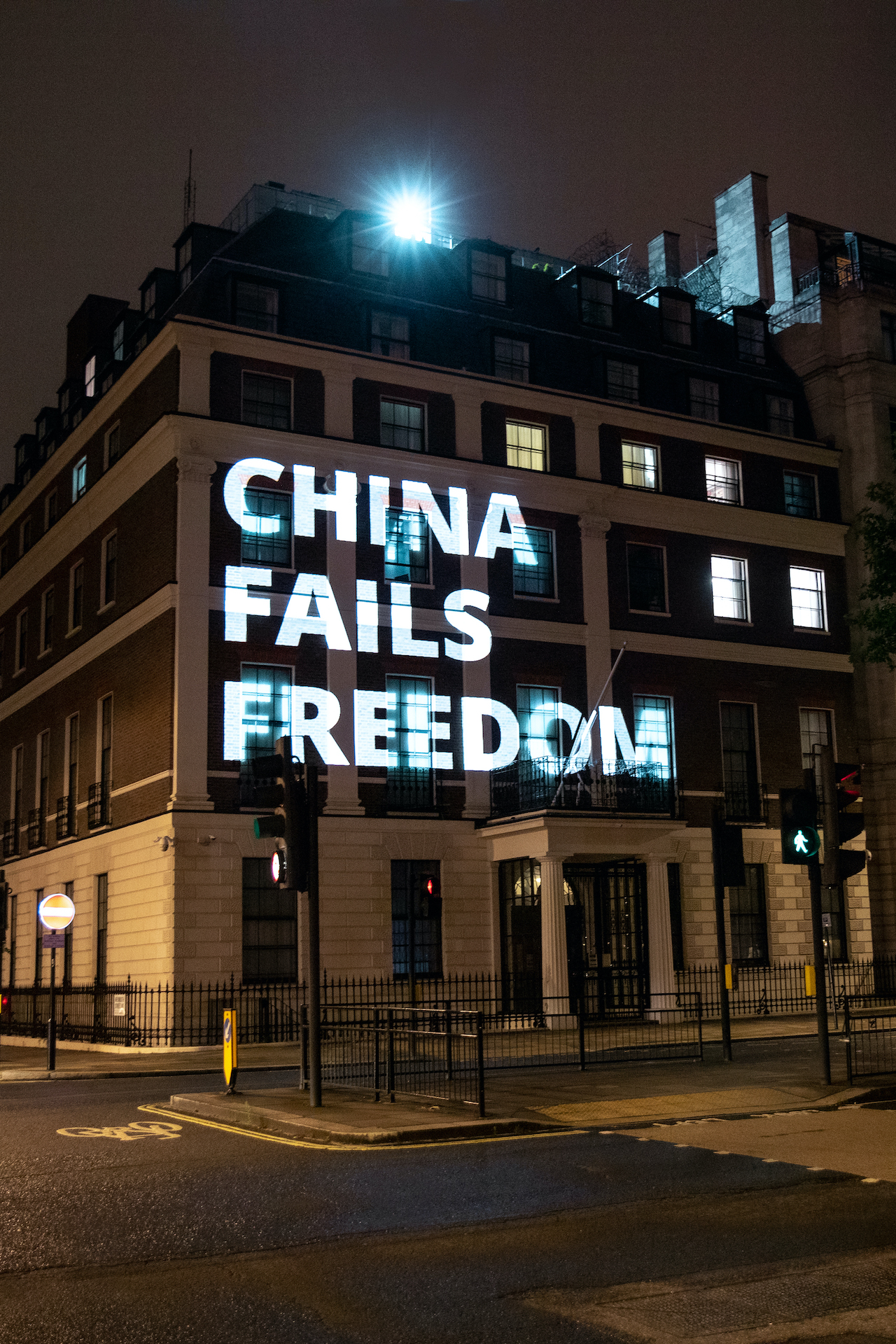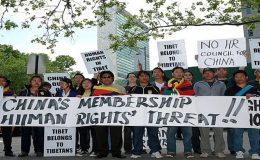Free Tibet Activists Challenge China with Daring Projection onto Chinese Embassy in London
The Economist and Apple were also targeted with messages calling on them to end their support and promotion of the Chinese Communist Party’s repression.
LINK TO PHOTOS AND VIDEO: Chinese Embassy | The Economist | Facebook Video | Twitter Video
[London] In the early hours of Friday 10 July, Free Tibet Activists carried out a series of bold projections across London, spotlighting China’s brutal brutal treatment of Tibetans, Uyghurs, Chinese and now Hongkongers.
The message, ‘CHINA FAILS FREEDOM: FREE TIBET, FREE HONG KONG, FREE UYGHURS’ was projected onto the Chinese Embassy in London, at around midnight BST, to highlight the chilling parallels between China’s long standing abuses in Tibet and East Turkestan, and the unfolding crackdown in Hong Kong.
Under China’s illegal occupation, Tibet has become one of the most closed and repressive places on earth. Innumerable Tibetans have been imprisoned for carrying out peaceful protests or even expressing their unique Tibetan identity. Torture and police brutality are routinely used to silence Tibetans voices. There have been explicit attempts by occupying authorities to limit the practice of Tibetan Buddhism, the teaching of the Tibetan language and expressions of Tibetan identity. For the past five years, the US organisation Freedom House has ranked Tibet as the second worst place in the world for civil rights and political freedoms, ranking it worse than North Korea and only closely behind Syria.
The Chinese government actively spies on individuals through mass surveillance programmes, and curtails Tibetans’ ability to share information with the outside world. For decades Tibet has also been used as a testing ground for one of the most intrusive regimes of mass monitoring and control in the world. These systems have been so ‘successful’ in Tibet that they have since been replicated in Uyghur regions, where at least 2 million are arbitrarily detained, and now risk being extended into Hong Kong.
The image projected onto the embassy sought to highlight how the struggles by Tibetans, Uyghurs and democracy activists in Hong Kong are linked. (1)
Activists also carried out projection protests at the Apple Store Covent Garden and the headquarters of The Economist, highlighting how both companies have facilitated the Chinese Communist Party’s repression and its intensive international propaganda efforts.
A video on the Apple Store challenged the company to reverse its decision to ban a range of apps from its App Store in China, including VPNs that Tibetans in occupied Tibet rely on to communicate safely with the wider world. Under China’s repressive rule, the vast majority of Tibetans have no access to the internet as we know it.
An image projected onto the headquarters of the Economist asked the newspaper’s editors whether they had dropped their collaboration with Beijing Review, a Chinese state media company under Chinese Communist Party [CCP] control. In early 2020, paid ‘advertorials’ branded ‘China Focus’, appeared in the Economist, lauding the CCP’s response to the COVID 19 outbreak. Beijing Review has run a number of controversial articles on its own website, claiming the mass re-education camps in East Turkestan are simply training centres that “bring hope” to Uyghurs, and hailing “60 years of democratic reform in Tibet.”
The protest actions across London are a result of close collaboration between Tibet activist groups Free Tibet and Students for a Free Tibet UK and the global ethical consumer group SumOfUs. (2)
John Jones, Campaigns and Advocacy Manager at Free Tibet, said: “The CCP won’t have enjoyed the events at the Chinese Embassy last night. The Party interprets freedom of speech as a challenge and a threat, hence its repressive rule in Tibet, its persecution of Uyghurs and its brutal crackdown in Hong Kong. Unfortunately, the CCP will not have its own way this time. For a brief moment, the Chinese Embassy was turned into a monument of resistance, a symbol of all those who resist CCP rule in the name of human rights, self-determination and freedom. Those images are now being shared around the world by people who are free to call the Party what it is: the largest, most systematic, most extensive threat to freedom in the world today. ”
Drukthar Gyal of Students for a Free Tibet UK, said: “There is a chilling parallel between what is happening in Hong Kong right now and the situation in Tibet where we have witnessed a ruthless and unabated crackdown on Tibetans for decades.The international community must not let China off the hook for its complete disregard for democracy, human dignity, and freedom, and we call on governments to throw their full weight behind Tibetans, Uyghurs and Hong Kongers and take immediate, joint action to challenge Beijing’s systematic repression.”
Tenzin Jigdal of International Tibet Network said: “China’s repressive policies must not go unnoticed. The actions in London spotlight how pervasive China’s repression is, and highlight just how many forms it takes. Governments and world leaders must establish and enforce concrete measures to prevent institutions and bodies from importing China’s suppression into their homeland and abroad.”
ENDS
CONTACT: For further information:
John Jones, Free Tibet, UK | +44 (0)777 068 1938 | john@freetibet.org
Drukthar Gyal, Students for a Free Tibet UK| +44 (0)7578 407 308 | drukthar@studentsforafreetibet.org
Tenzin Jigdal, International Tibet Network | +91 9805274608 | jigdal@tibetnetwork.org
Mandie McKeown, International Tibet Network | +44 (0)7748 158 618 | mandie@tibetnetwork.org
Notes for editors
- “Tibet was used as a laboratory to try out oppressive new measures of total surveillance, an “iron grid” system of securitization and accelerated cultural assimilation in order to create compliant citizens and Party subjects. Under the leadership of soldier-turned-politician Chen Quanguo, Party chief of Tibet before being transferred to Xinjiang in 2016, Tibetan news sources were shut down and replaced by Community Party outlets with the aim of ensuring that “no voices and images of enemy forces and Dalai clique can be heard or seen.” Hundreds of thousands of Party cadres were sent to Tibet in a dramatic escalation of intrusive measures into the everyday lives of Tibetans, combined with tougher measures to eliminate the remaining influence of lamas and traditional leaders within Tibetan communities.” China’s Hidden Crackdown in Tibet, The Diplomat, 22 April 2020: https://thediplomat.com/2020/04/chinas-hidden-crackdown-in-tibet/
“China’s National People’s Congress set in motion new, restrictive legislation for Hong Kong. Activists in Hong Kong have already dubbed this move as the final nail in the coffin of the Basic Law, which guaranteed the people of Hong Kong a high degree of autonomy to govern their own affairs.Beijing has previously made promises of autonomy in other restive regions — like Tibet. Grasping how Chinese leaders have repeatedly offered Tibetan autonomy, only to rescind it, reveals what the future might hold for Hong.” What’s in store for Hong Kong? Look at Tibet, Washington Post, 2 June 2020: https://www.washingtonpost.com/politics/2020/06/02/whats-store-hong-kong-look-tibet/
“Drawing parallels between Chinese policies in Xinjiang and Tibet, Brownback urged
panelists to take note of the name of one particular Chinese official who oversees Xinjiang affairs, Chen Quanguo. He was first placed in Tibet to test a massive grid of physical and technological surveillance and life in Tibet, including religious life, was forever transformed, the ambassador said. “Considered it a success, Chen took his playbook to Xinjiang, amplifying his tactics at an unfathomable scale.” China replicates Tibet repression in Xinjiang: Beijing waging ‘war on faith, truth and international norms,’ says US Ambassador for International Religious Freedom, Anadolou Agency, 19 December 2019: https://www.aa.com.tr/en/asia-pacific/china-replicates-tibet-repression-in-xinjiang-expert-/1678595 - The projections were coordinated by International Tibet Network, a global coalition of over 120 global Tibet related groups.





